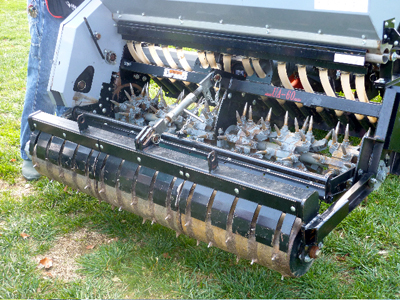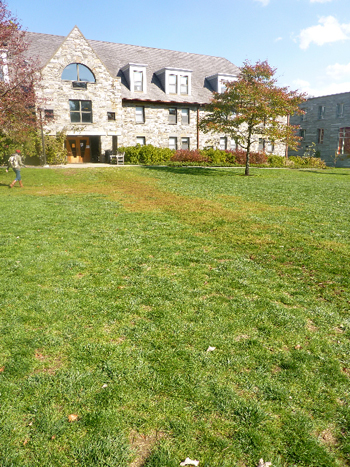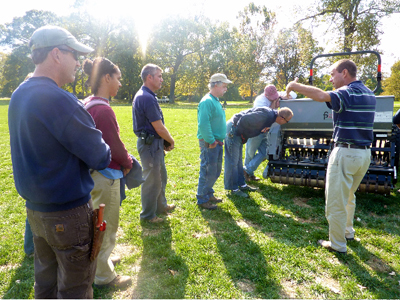Remediating Compaction on our Organic Lawn

By Erin Curtis, Student Organic Lawn Coordinator
The Arboretum recently achieved another step in the transition to an organic lawn maintenance program for Mertz field. We had a demonstration of the “AERA-vator” aeration machine, which loosens highly compacted soil to induce root growth in plants and facilitate nutrient dispersal in the soil. This is a crucial step included in the protocol from our consultant, Eric T. Fleisher. Before our first batch of compost tea is applied, we need to loosen the soil so that the liquid can penetrate further and facilitate microbial activity deep into the root zone.
Not only does compaction limit the depth of percolation of water and nutrients added by the gardener, but also the natural movement of soil organisms that digest and mix organic matter. Compaction occurs when an outside force compresses soil particles together so that little air space remains underground. Healthy soil consists of about fifty percent air and water, which is necessary for plants adequate access to nutrients. Compaction also physically impedes root growth, which in turn limits the plants ability to soak up water and important nutrients. The grass roots are unable to reach farther into the soil and thus cannot access as large a volume of soil along with the water stored in it.

Foot traffic from Mertz dorm to Sharples dining hall has caused this browning of Mertz field. The compaction of the soil has caused the grass to die and be replaced by weeds. photo credit: E. Curtis
As the picture above shows, many weeds have colonized in the grass of Mertz field. In particular, annual bluegrass, white clover, plantain and dandelions are a problem. The vigor of these species over that of turf grass is usually an indication of soil compaction, as these weeds are adapted to survive and thrive in compacted soil. Without addressing the underlying problem of compaction, however, the prevalence of the weeds cannot be combated. Thus, compaction not only has direct effects on roots and retention of water and nutrients, but it also has indirect effects, including that of invasive weeds outcompeting the desired turf grass species.
Compaction is a significant problem in many fields — but what causes this compaction? The compacting force can come from vehicles, heavy machinery, or even foot traffic. Compaction is a common problem on lawns everywhere, and Mertz field is no exception to this where it is difficult to dig even a small hole in the soil. The field has daily human traffic and was heavily compacted by machinery during the construction of Alice Paul and David Kemp Residence Halls. The field also served as the main practice field for the Ultimate Frisbee team for years.
To solve the problem of compaction, many school districts, municipalities, and athletic organizations use aeration: a large machine churns long tines into the soil, loosening it and introducing air gaps. Our aerator of choice is the “AERA-vator” from First Products — the same aeration machine used by the Phillies. The tines in the AERA-vator vibrate to fracture the soil both underneath and around the machine rather than simply pulling out a plug of soil; this way, the soil is loosened over a wider area and to a greater depth than the tines actually reach. The aerator previously used, a standard type that pushes down under its own weight and pulls out plugs, cannot penetrate even to the full depth of its tines through soil as dense as ours. An aerator that is able to combat compaction effectively is essential for a successful organic lawn.
[jwplayer mediaid=”2602″]
The AERA-vator apparatus broke through the soil in Mertz field on a beautiful October day when the field was dry enough to aerate.. The first two attempts had to be rescheduled due to weather — when the soil is too wet after a heavy rain, the aeration can do more damage than good, potentially ripping grass from the soil, and the heavy tractor leaving excessively compacted tracks.

The demonstration of the AERA-vator. photo credit: E. Curtis
The machine arrived by truck and was towed by tractor to Mertz Field. The company representative led a group of staff from Grounds and the Arboretum through a demonstration of the machine. The aeration happens through an apparatus towed by the tractor: a large cylinder with many slender 4” tines that vibrate back and forth as it moves forward across the lawn. While in the soil, these tines move back and forth, fracturing the soil between them, rather than just puncturing holes in the ground.
The AERA-vator was indeed effective at loosening the soil, at least in the first few inches: after a pass with the AERA-vator, the ground was noticeably softer to the step. When the compaction was measured with a penetrometer, a device that measures the resistance from the soil when a probe is inserted, the compaction pressure went from about 13.5 force-pounds to about 10 force-pounds, and the probe sank deeper into the soil before it encountered measurable resistance.
After the field was aerated, we were able to begin the application of compost tea. During the month since the field’s aeration, we have brewed and applied about 500 gallons of compost tea to the five acres. Through the winter and early spring, we will have compost — made from the College’s own garden trimmings and dining hall refuse — sifted and spread thinly over the lawn. The infusion of organic matter will add nutrients and will improve the ability of the underground environment to exchange and retain these nutrients and feed the ecosystem of organisms that the compost tea introduced.
Next spring, we will repeat the aeration process and compost tea application, as well as over seeding with a mixture of vigorous turf grass species. Keep your eyes out for more photos and details in a Hybrid article about the organic lawn project soon!





No Comments